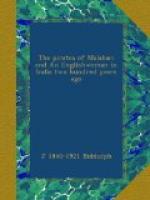In the hope of securing some portion of the money due to the Company, the Council attached the brigantine Thomas, commanded by Mrs. Gyfford’s brother. A letter was at once forthcoming from Matthews to say that he had purchased Mrs. Gyfford’s interest in the vessel. Finding themselves thus forestalled, the Council begged Matthews not to take her away from Calcutta till she had furnished security for the Company’s claim of Rs.50,000, Matthews replied that he should take her to Bombay, where she would answer anything that might be alleged against her. As soon as he had completed his trading in Bengal, Mrs. Gyfford, with her effects, embarked on board the Lyon, and so returned to Bombay. There, in January, 1723, we find her living under Matthews’ roof, much to the wrath of the Council and the scandal of her former acquaintances. By this time, the Council had received from Anjengo more precise details as to what was due to the Company from Gyfford’s estate. All the cowries, pepper, and cloth that were said to belong to Gyfford had been bought with the Company’s money, and the Company’s claim against his estate was nearly L9000. A stringent order was sent to Mrs. Gyfford, forbidding her to leave Bombay till the claim was settled. Matthews at once put her on board the Lyon again, and there she remained; not venturing to set foot on shore, lest the Council should lay hands on her.
By the end of the year, Matthews was ready to return to England. Intent to the last on trade, he touched at Carwar, Tellicherry, and St. David’s, and, in Mrs. Gyfford’s interests, a visit was also paid Anjengo, to try and recover some of the property she claimed to have left there. She was not going to be put off with Lapthorne’s ‘two wiggs and a bolster.’ In July (1724) the Lyon reached Portsmouth, and was put out of commission.
At first the Directors appear to have paid little attention to Mrs. Gyfford, perhaps not thinking her worth powder and shot. Their principal anger was directed against Matthews, against whom they obtained a decree in the Court of Chancery for unlawful trading. But Mrs. Gyfford would not keep silence. Perhaps she really believed in the justice of her claims. She bombarded the Directors with petitions, till at last, two years after her arrival in England, they tardily awoke to the fact that they themselves had substantial claims against her. They offered to submit the claims to arbitration, to which Mrs. Gyfford consented; but as she still refrained from coming to close quarters, they filed a suit against her in the Court of Chancery, nearly four years after her arrival in England. Mrs. Gyfford promptly replied with a counter-suit, in which, among other things, she claimed L10,000 for presents taken by Gyfford to the Rani of Attinga on that fatal 11th April, seven years before. Four years later, she was still deep in litigation, having quarrelled with her agent, Peter Lapthorne, among others. It is to be hoped,




